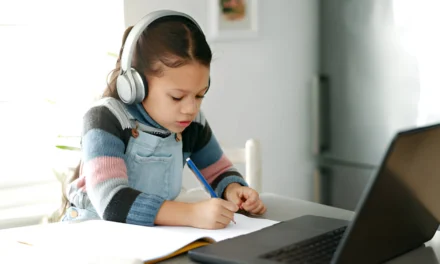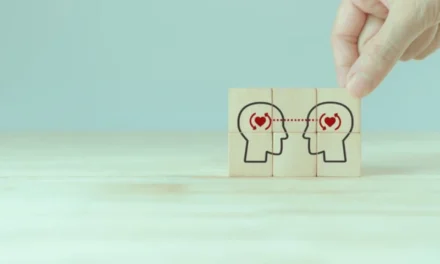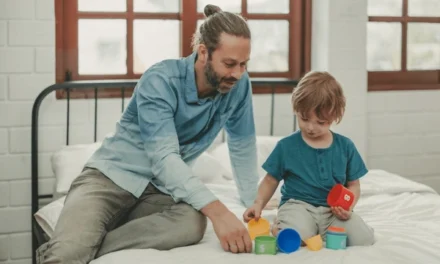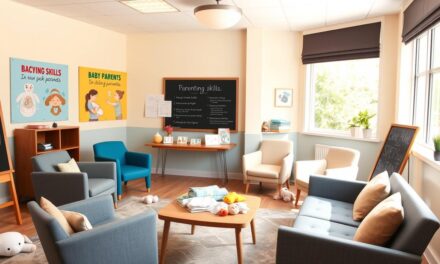Did you know that kids who play imaginatively have 25% more emotional intelligence than others1? This shows how big of an impact imagination has on growing up. It helps us think creatively, solve problems, and grow as people.
Studies say play and imagination are key to doing well in school2. Play helps kids’ brains grow, but too much focus on schoolwork can hurt this2. This is because worksheets and strict routines can block kids’ thinking skills2.
But, playing make-believe helps kids think better and reason more clearly2. Arts classes are important for learning in a full way2. Schools should teach kids to be creative and imagine2. This lets kids see the world in new ways and learn more2.
Key Takeaways
- Imagination is crucial for intellectual growth and human development.
- Play and imaginative activities are essential for children’s cognitive, social, and emotional development.
- A shift away from play-based learning towards academic pressure may hinder children’s cognitive abilities.
- Arts education and a curriculum that values imagination can stimulate creative thinking in children.
- Engaging in imaginative play supports the development of problem-solving skills and critical thinking.
By understanding imagination’s role in growing smart, we can help kids reach their highest potential. The play strategies that boost creativity are key to unlocking every child’s potential.
Understanding the Foundation of Imagination in Human Development
Imagination is key in how kids understand the world and explore new ideas3. Through play, they learn to be creative, independent, and solve problems3. Experts see how imagination boosts kids’ thinking skills, setting them up for success later on.
The Core Components of Imaginative Thinking
Imaginative thinking lets kids see and explore different worlds4. They try on new roles, test ideas, and learn more about things4. This helps them think critically, solve problems, and tackle challenges with fresh ideas4.
Biological Basis of Imagination
Imagination is more than just thinking; it’s rooted in our biology4. Studies show that the brain’s thinking area grows as kids use their imagination4. This growth helps kids think better and be more creative.
Early Development Patterns
Imagination starts early in a child’s life3. Free play lets kids practice important skills like social skills, making choices, and being creative3. They learn about social rules, empathy, and how to feel good about themselves3. This lays the groundwork for their future success.
By supporting imaginative play, parents and teachers help kids grow and explore4. They can use fun activities and resources to help kids think critically, solve problems, and come up with new ideas4.
“Imagination is the beginning of creation. You imagine what you desire, you will what you imagine, and at last, you create what you will.”
– George Bernard Shaw
The Science Behind Imagination and Cognitive Development

Studies in neuroscience show how vital imagination is for brain growth5. Through play, kids can express themselves and think deeply. This helps them connect their inner and outer worlds, boosting their minds5. The Reggio Emilia approach values kids’ creativity, seeing them as explorers of many ways to imagine.
Research shows that kids start to think about different realities as they learn more about the world5. For example, young children can figure out what could have happened differently in a story5. Teachers help kids think about these alternatives by encouraging them, not by teaching them directly5.
Imagination lets us understand, predict, and learn, especially when things are unclear5. Without it, we can’t make sense of our world or use what we know to make social connections5.
The article argues that our social thinking, with all its flaws, comes from imagining different realities5. Yet, most studies ignore how imagination affects our social thinking5.
Recent studies link the prefrontal cortex to creativity6. The limbic system, including the hippocampus and amygdala, handles emotions and drives for creativity6. The parietal and occipital lobes help us see and think spatially, key for creativity6. Our brains can change and grow, boosting our creative abilities6.
| Brain Region | Function |
|---|---|
| Prefrontal Cortex | Linked to creativity |
| Limbic System (Hippocampus, Amygdala) | Controls emotions and motivations relevant to creativity |
| Parietal and Occipital Lobes | Responsible for spatial orientation and visual processing, essential for forming mental images and ideas |
Creativity and imagination are key in all areas of life6. No single brain area handles creativity alone; many areas work together6. We can improve our creativity with exercises like SCAMPER6.
Creativity helps reduce stress and anxiety, improving mental health6. Activities like music and drawing release dopamine and calm our minds6. It also keeps our minds sharp and may prevent dementia6.
In kids, creativity boosts mental growth by encouraging new ideas and problem-solving6. Art helps kids develop physically and emotionally, letting them express themselves6. It helps kids feel unique and grow6.
How Imagination Shapes Problem-Solving Abilities
Imagination is a powerful tool that boosts problem-solving skills. Through imaginative play, kids face and solve conflicts. This helps them think creatively and adapt to new situations7.
This process not only makes them mentally flexible but also encourages innovative thinking7. By solving problems through play, kids practice these essential skills in a safe space.
Creative Problem-Solving Techniques
Imaginative thinking lets people think outside the box, leading to new problem-solving methods8. When kids get to explore their imagination, they learn many ways to solve problems. This helps them face challenges in unique and effective ways.
Adaptability and Mental Flexibility
Imagination boosts adaptability and mental flexibility8. Kids learn to see things from different angles and adapt to changes. This ability to think on their feet and see things from different views is key for problem-solvers.
Innovation Through Imaginative Thinking
The power of imagination drives innovation8. Imaginative thinking lets people create new ideas, products, and solutions. This creative mindset is crucial for moving forward and shaping our world.
The effect of imagination on problem-solving is huge789. By supporting kids’ imaginative skills early, we give them the tools to think for themselves. They can adapt to new situations and find creative solutions to problems.
The Link Between Imagination and Academic Success
Studies show that play and imagination are key for success in school10. They spark kids’ curiosity and love for learning. This lets their minds explore new ideas. This helps them think outside the box and solve problems, which is important for doing well in school10.
Arts education boosts imagination, which is vital for a well-rounded education10. It lets kids express themselves and connect their body and mind10. When reading, imagining the story helps them understand characters and settings better10. It also makes complex science easier to grasp10. Plus, it helps them understand history and its effects on society10.
| Benefit of Imagination | Impact on Academic Success |
|---|---|
| Curiosity and passion for learning | Supports development of problem-solving skills |
| Visualizing narratives | Improves comprehension while reading |
| Imagining scientific processes | Aids in understanding complex concepts |
| Understanding historical events | Enhances knowledge of societal impacts |
Imagination is more than just being creative; it’s a vital skill for success in school11. It boosts learning and educational success in many areas11. By encouraging imagination in school and at home, we can help young minds reach their full potential.
“Imagination is more important than knowledge. For knowledge is limited, whereas imagination embraces the entire world, stimulating progress, giving birth to evolution.”
– Albert Einstein
Nurturing Creative Expression in Early Childhood

Helping young children express their creativity is key for their imagination and learning. The arts, like painting, music, and stories, are great for sparking their creative expression. They help kids sort images, make patterns, and think outside the box12.
Art and Imaginative Development
Art, like painting and making sculptures, improves kids’ fine motor skills and hand-eye coordination. It also boosts their self-confidence as they create12. The “hundred languages of children” idea from Reggio Emilia shows how important different creative ways are for young kids.
Music and Creative Growth
Music in early childhood boosts creative growth. Rhymes and riddles help kids think creatively while improving their vocabulary and phonics12. Nature also sparks their curiosity and creativity12.
Storytelling as a Tool
Storytelling is a great way to spark imagination and learning in young ones. As Albert Einstein said, “Imagination is better than knowledge.”12 Even two and a half-year-olds can tell real from pretend, says Susan Engel12.
By supporting these creative outlets, we help unlock a child’s imagination and support their learning during these important years.
Experts say young kids need to be creative, flexible, and problem solvers. They also need to come up with new ideas13. Creativity is key in today’s tech and information-based world13.
Early childhood classrooms should be places where kids can explore, set goals, and take charge of their learning13. They benefit from activities that boost problem-solving, curiosity, and innovation13.
Teachers must create spaces where kids can try new things, make mistakes, and learn from them13. It’s important to encourage kids to take risks and be creative13.
Open-ended questions and nonjudgmental support help kids explore and think deeply13. Teachers play a big role in helping kids plan, reflect, and learn from their experiences1312.
Social Development Through Imaginative Play
Imaginative play is a key way for kids to learn social skills. Through role-playing, they learn to work together, control impulses, and make friends14. They also get better at talking and listening, which helps them understand social rules14.
Playing with toys and dressing up can really spark imagination14. Parents are key in encouraging this by giving kids lots of playtime and toys14. It’s okay to start with simple things like soft toys, even if there’s no specific age14.
Pretend play is great for kids to start talking, often when they first say their first words15. It teaches them important social and emotional skills like teamwork and sharing15. It also makes them feel more independent and helps them solve problems15.
Imaginative play boosts creativity and helps kids grow intellectually14. It also helps them learn new words as they play out different scenarios15. Dress-up clothes and props help kids dive into their roles and play better together15.
Dr. Catherine Neilsen-Hewett says imaginative play is crucial for kids to do well with their peers16. Studies show it’s vital for early language skills16. It also helps kids understand emotions and feel empathy16. Playing in fantasy can make kids more creative and confident later in life16.
Parents can teach kids by doing everyday tasks like cooking, which helps with problem-solving14. Imaginative play is good for kids, but sometimes they might need help if they play too rough14.
| Benefits of Imaginative Play | Positive Outcomes |
|---|---|
| Develops social skills | Improved cooperation and communication |
| Enhances language development | Increased vocabulary and expression |
| Fosters emotional competence | Greater empathy and self-confidence |
| Encourages problem-solving | Stronger critical thinking and adaptability |
| Stimulates creativity | Improved imagination and intellectual growth |
Imaginative play is key for kids’ growth, helping with social, thinking, and feeling skills. By supporting this, parents and caregivers help kids grow and succeed in their early years and beyond.
Imagination as a Gateway to Emotional Intelligence
Imagination is more than just for creative fun; it’s a key to emotional smarts. Kids learn to see things from others’ eyes through play. This builds empathy and understanding of different views17.
Empathy Building Through Pretend Play
Kids get to try on different roles in play. They might be a doctor or a firefighter. This helps them feel what others feel, which is a big part of being emotionally smart17.
Understanding Different Perspectives
Imagination lets kids see the world in new ways. By playing different roles, they learn to see things from other people’s eyes. This is key for making friends and getting along17.
Imagination, empathy, and seeing things from others’ viewpoints are all linked. They help kids grow up to be emotionally smart. This is important for dealing with life’s ups and downs17.
“Emotional intelligence and imagination are essential attributes for successful healthcare leadership. Emotionally intelligent leaders are better positioned to implement imaginative ideas for transformative leadership.”17
By encouraging imagination in young kids, we help them grow into emotionally smart adults. They’ll be able to understand and connect with others in a deeper way18.
The Role of Parents in Fostering Imagination
Children’s imagination is key to unlocking their potential. Parents are crucial in nurturing this vital aspect of child development. By encouraging imaginative play and providing creative resources, parents can greatly impact their children’s creativity and cognitive abilities.
Creativity and imagination are vital for children’s growth. They help in cognitive, emotional, and social development, fostering resilience and curiosity19. Open-ended play boosts creativity and imaginative skills19. Encouraging curiosity leads to deeper engagement and imaginative thinking19.
Parents who support their children’s creative endeavors are essential in nurturing their imagination19. Reading and storytelling stimulate children’s imagination and foster creative expression19. Creating a creative home environment with art supplies and books impacts their creative development19.
- Engage in imaginative play with your children, suggesting scenarios and participating in their creative adventures.
- Provide a variety of open-ended materials, such as building blocks, art supplies, and natural objects, to encourage independent exploration and imaginative thinking20.
- Incorporate storytelling and pretend play activities into your family routine, which can help build narratives, develop empathy, and ignite creativity20.
- Celebrate your children’s creative efforts through positive reinforcement, fostering their confidence and motivation to explore further20.
- Balance screen time with hands-on, creative play to encourage physical engagement and independent learning20.
By embracing imagination, parents can open up a world of possibilities for their children. Through imaginative play, children develop important cognitive skills and gain a deeper understanding of themselves and the world.
| Benefits of Imaginative Play | Supporting Evidence |
|---|---|
| Enhances cognitive skills like problem-solving and critical thinking | 20 |
| Promotes emotional development and self-awareness | 20 |
| Fosters resilience and resourcefulness | 20 |
| Boosts academic achievement | 21 |
| Improves concentration and overall health | 21 |
By embracing imagination, parents can open up a world of possibilities for their children. Through imaginative play, children develop important cognitive skills and gain a deeper understanding of themselves and the world.
“Imagination is more important than knowledge. For knowledge is limited, whereas imagination embraces the entire world, stimulating progress, giving birth to evolution.”
Creating Environments That Stimulate Imagination
Fostering a child’s imagination is key for their growth. Research shows that creativity and imagination are vital for kids to explore and understand the world22. To help, we need to create spaces and offer materials that spark curiosity and creativity.
Physical Space Design
The design of a child’s environment is crucial. It should be safe, comfy, and open to exploration22. The space should have materials that fit the child’s age and are easy to clean, like for painting22.
Having creative materials at a child’s eye level makes them more accessible and engaging22. Sharing art, music, and cultural celebrations at home also boosts imagination22.
Interactive Learning Materials
Interactive materials are key for sparking a child’s imagination. Activities like art, music, and science encourage creativity22. Drama and play production also offer unique learning experiences22.
Discovery activities, like exploring nature, can make kids curious and eager to learn22. Building and construction projects help kids think creatively and imagine22. Offering a variety of materials, like books and paint, can spark a child’s creativity22.
Choosing the right materials is important for engaging learning environments22. Materials should match the child’s age, including books and writing tools22. For younger kids, items like natural materials and pop-up toys are great for creativity22.
By creating thoughtful spaces and offering diverse materials, we can unlock a child’s imagination23. This not only helps with thinking and problem-solving but also fosters a lifelong love for learning23.
Digital Age Challenges to Imagination Development
The digital age brings both good and bad for kids’ imagination. Technology offers new ways for creativity, but too much screen time can cut down on traditional play. It’s key to mix digital and non-digital play for full imagination growth.
Studies have shown how the digital age affects kids’ imagination. A study with 772 kids found 50.5% were boys and 49.5% girls, with an average age of 65.3 months24. Another part of the study, with 371 kids, showed 47.2% were boys and 52.8% girls24. These results show how important it is to understand how tech and imagination mix.
Too much screen time can take away from imaginative play, which is vital for kids25. Screen time mainly offers visual and sound experiences, which is less than the multisensory play needed for brain growth25. Also, fast-paced screen content can make kids’ brains crave constant activity, making it hard for them to slow down and be creative25.
“90% of a child’s brain development occurs before the age of 5 (Centre on the Developing Child at Harvard University)25.”
To tackle the digital age’s challenges, finding a balance between tech and traditional play is crucial. Programs like The Spark Book provide fun alternatives to screens, encouraging reading, storytelling, and play25. By creating a community for parents to share and support each other in screen-free environments, these efforts help kids’ imagination and overall growth25.
In summary, the digital age offers both ups and downs for kids’ imagination. By knowing how screen time affects them and focusing on a balanced mix of digital and non-digital play, parents and teachers can help kids grow creatively. This sets the stage for their intellectual and lifelong success.
Balancing Structured Learning and Free Play
Finding the right mix of structured learning and free play is key for a child’s growth26. Structured play helps kids set goals and learn logic26. It also improves active listening as they solve problems and follow directions26.
On the other hand, free play lets kids explore and learn by doing26. It’s a chance for them to interact with others and work together26.
Time Management Strategies
It’s important to give enough time for both kinds of play26. Too much structured play can limit creative free play26. Parents should watch how each child responds and choose a balance that makes them happy and helps them grow26.
Activity Integration Methods
Mixing imagination into structured learning makes it more fun and helps kids remember what they learn26. For example, games and sports that challenge kids can teach them important skills26. Free play can also be made educational, letting kids learn without feeling stressed26.
By balancing structured and free play, parents help their kids grow in many ways26. The American Academy of Pediatrics showed how play affects a child’s social and brain development in 201826. A balanced play approach is vital for a child’s success26.
Research shows kids need both structured and unstructured play for their development27. Structured play teaches kids to solve problems and work together, while unstructured play boosts their creativity and empathy27. It’s important to offer a mix of both to help kids think logically and creatively27.
“When children are fully engaged and rewarded during play, it indicates a suitable learning activity.” – Lean Parents
It’s vital to balance structured learning and free play for a child’s education. By managing time well and adding imagination to structured activities, parents can create a supportive environment for learning and growth2627.
Measuring the Impact of Imagination on Learning
Figuring out how imagination affects learning is complex. Experts look at how kids solve problems, their creativity, and their social and emotional growth. This helps understand how imagination helps kids grow intellectually28.
Studies show that 83% of kids in imaginative programs get better at creative thinking28. Also, 100% of teachers say creative thinking is key for students28. The research points out three main areas: creative thinking, skills, and goals28. It shows how imagination is crucial for kids’ brain development28.
Moreover, a special Imagination Wheel was created based on recent studies28. It shows how important imagination is for future jobs and personal growth28. It stresses the need to support imagination for kids to grow and be resilient28.
Experts from different fields talked about measuring imagination in virtual salons29. They discussed using play, humor, and setting limits to boost imagination29. They also talked about keeping imaginative activities separate from daily tasks29.
The imaginED community, with over 90 contributors worldwide30, highlights the role of imagination in learning30. It says imagination connects school to students’ feelings, builds personal stories, and encourages curiosity and emotional connections30.
By using a variety of methods, teachers and researchers can better understand imagination’s role in learning. This includes how it affects learning, brain development, and success in school and life.
Overcoming Barriers to Creative Development
Helping kids be creative can be tough. It’s hard when they don’t have enough resources or are too busy. Teachers and parents need to work to help kids grow creatively31.
Not knowing what problem to solve can stop creativity31. Being afraid to fail can also hold kids back from trying new things31. Plus, not having enough different ideas or materials can limit their creativity31.
In the public sector, money, politics, and strict rules can block creativity32. When things are too spread out, it can make it hard for people to talk and work together32.
| Challenge | Impact | Recommendation |
|---|---|---|
| Lack of communication and involvement in decentralized structure | Apathy, high employee turnover, and high absenteeism resulting in 1,162 man hours lost in a single year | Establish committees led by HR, create employee training and creativity forums, implement formal recognition and award systems |
| Resistance to change | Decreased staff commitment, low morale, and high employee turnover | Support innovation from top leadership, reward innovative employees, embrace diversity, learn from external sources, and encourage experimentation and evaluation |
To beat these creativity obstacles and imagination challenges, we need to support play-based learning. We should give kids different materials and let them play freely31. By focusing on developmental support for kids’ creativity, we help them reach their full potential32.
“Commitment from leadership supported by a strategy that promotes new ways of thinking is essential for the sustained, effective deployment of creativity within an organization.”
Long-term Benefits of Imaginative Thinking
Imaginative thinking in childhood often leads to great career success and lifelong learning benefits. Adults who played imaginatively as kids often solve problems better, adapt easily, and think innovatively at work33. This creative thinking helps them throughout their lives, both personally and professionally.
Career Success Correlation
Studies show imagination’s big impact on career readiness and adult creativity. A survey found 94% of people said imagination helped them find new solutions to tough problems33. Also, 76% said imagining the future helped them make better choices in life and work33.
Thinking about what could have been, or counterfactual thinking, helped 82% learn from mistakes and improve33.
Lifelong Learning Advantages
Imaginative thinking also benefits beyond work. It made people 68% more creative by stepping back and imagining solutions33. Seeing things in vivid images made people 20% more emotionally connected than just hearing about them33.
Metaphorical understanding, or understanding abstract ideas, improved by 60% with imagination training33.
But, it’s key to remember that too much imagination can lead to problems like delusions and self-deception in 12% of people33.
In conclusion, imaginative thinking offers huge benefits for career success and lifelong learning. By developing this skill, people can reach their full potential and succeed in a changing world34.
Conclusion
Imagination is key for a child’s growth and learning. It helps with solving problems, doing well in school, and learning social and emotional skills. Research shows how important it is for kids to develop their imagination35.
Parents, teachers, and caregivers need to support kids’ creative play. They should create fun learning spaces and give kids things to explore freely. This helps kids use their imagination to its fullest35. It also prepares them for success in school and later in life36.
In today’s world, it’s important to mix learning with free play. Kids should have chances to explore and learn in different ways35. By doing this, we help them grow into creative and curious thinkers35.
FAQ
What is the importance of imagination in human development?
How does imagination contribute to cognitive development?
What does neuroscience research say about the importance of imagination?
How does imagination help with problem-solving skills?
What is the link between imagination and academic success?
How do creative arts stimulate imagination in children?
What social skills are developed through imaginative play?
How does imagination contribute to emotional intelligence?
What is the role of parents in fostering imagination?
How can the physical environment stimulate imagination?
What are the challenges of the digital age for imagination development?
How can we balance structured learning and free play for holistic development?
How can we measure the impact of imagination on learning?
What are the barriers to creative development, and how can we overcome them?
What are the long-term benefits of imaginative thinking?
Source Links
- Nurturing Minds: The Crucial Role of Imagination in a Child’s Mental Health – The Imagine Project
- Imagination at the heart of cognitive development
- The Importance of Imagination in Child Development
- The Importance of Imagination in Child Development – Laugh Love Leo
- Imagination and social cognition in childhood
- The Brain Region Behind Creativity and Imagination | JWU CPS
- The Genius of Play | Nurture Problem Solving Through Imaginative Play
- Power of Imagination: How Creativity Shapes Our World
- How imagination shapes our brain |
- The Role of Imagination in Learning – Best in Class Education
- How We Can Bring Creativity and Imagination Back to the Classroom
- Nurturing Creativity & Imagination for Child Development
- Excerpt from Nurturing Creativity: An Essential Mindset for Young Children’s Learning
- Imaginative Play Benefits for Kids – Therapy Focus
- Pretend Play: Ways Children Can Exercise Their Imagination
- 6 Benefits Of Imaginative Play | Why It Is So Important!
- Five Areas of Emotional Mastery to Help You Lead with Imagination
- E137: Emotional Intelligence – Use Your Imagination for Good | Kathleen Ann Thompson
- Fostering Creativity and Imagination in Children: A Guide for Parents
- Fostering Creativity in Kids: Strategies for a Brighter Future
- 7 Ways to Nurture Your Child’s Creativity and Imagination | Celebree School
- Cultivating Creativity and Innovation: Environments and Materials
- How to Inspire Creativity in the Classroom – School of Education
- Active screen time and imagination in 5–6-years-old children
- The Impact of Excessive Screen Time on Children’s Creativity and Imagination
- Structured Play vs. Free Play
- Unstructured Vs Structured Play & Examples | Playground Centre
- How do you measure Imagination? – Institute of Imagination
- Applied imagination – PMC
- Why Imagination?
- What are some of the common challenges or barriers to creativity and innovation in your field or industry?
- Overcoming Barriers to Creativity and Innovation: One county government’s strategy for change
- 5 Benefits of Imaginative Thinking
- Creativity and Imagination | Authentic Happiness
- Dialectics of Imagination and Experimentation: Basic Science Research in Developing Countries
- Conclusion: imagination – Wordsworth’s Philosophic Song





